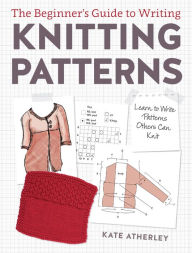Kate Atherley has long served as the technical editor of Knitty.com, the oldest and largest curated online magazine of free knitting patterns. Tasked with editing patterns from often new or previously unpublished designers, she's seen her share of the good and the bad, the eloquent and the obtuse. She has dug herself out of many a trench, and it is from this hard-earned experience—and perhaps in the hopes of making her own job easier in the future—that Kate wrote this book.
The Truth of the Matter
Not all great designers are great pattern writers, just like not all great musicians make good teachers. Writing patterns is a skill in itself, one that should be respected, studied, practiced, and constantly refined. Start by reading this book. Even if you don't aspire to become the next Ysolda Teague, you'll still benefit from learning about the common danger zones in patterns and how to analyze your way out of them.
The Beginner's Guide to Writing Knitting Patterns contains years of hard-learned wisdom distilled into an easily read, infinitely helpful guide. It contains a multitude of examples of common challenges and ideal ways in which they can be overcome, all based solidly in best-of-class, real-world examples. As an added bonus, the book is peppered with tips and anecdotes from other established knitwear designers, too.
Kate had me frequently nodding in agreement as she walked through the very basics of a written pattern, from the common structure and elements (gauge, measurements, abbreviations, etc.) to the actual instructions and any accompanying charts and schematics. She brings in examples at every turn, ones you're likely to recognize from your own frustrations. For example, she addresses the tricky territory of gauge and when to list the pattern's gauge in stockinette versus a stitch pattern, and when it's best to provide both.
Words Matter
I've spent time with Kate and can tell you two things about her: She is passionate about her work, and she's extremely precise in her language. Get her going on a design issue, especially something common and sloppy, and she'll talk all night—and you'll want to listen. That same passion for precision shines clearly here. Kate presents reason after reason why precision matters in each line and at each step of writing a pattern, and why you'll benefit as a designer if you pay attention to these details.
Common Peeves
What kind of precision am I talking about? Here's an example. It's very easy to say "S1" when you want someone to slip a stitch, for example, but she argues the vital need to go one step further and indicate whether you want that slip stitched knitwise or purlwise. Such information is equally helpful to non-designers, who will now know to raise a red flag when they see this in a pattern.
On the topic of grading patterns, Kate argues that that telling someone to change their needle size to knit a different size of a garment is not grading. It will not appropriately help you scale that pattern to a different size. (I can almost hear her pound her fist on the table as she says it.) Oh, and by the way, please don't tell people to place a stitch marker next to a yarn over. The marker will slip through the YO and cause no end of confusion.
It's those kinds of insights, big and small, that make this book so invaluable for us all. Whether you're looking to make a career out of writing patterns or just want to get better at identifying red flags in other people's patterns or writing down your own inventions, this book will chart your way.
Kate is very upfront about what this book is intended to offer and what it will not. It will not, for example, teach you how to design, nor will it teach you how to photograph or market your work. There are other resources for that. But it will teach you how to formalize and streamline your written instructions to be easily followed by as broad a group of people as possible.
Designers: It is not a replacement for solid technical editing, but it will make your tech editor love you even more.
![]() Buy the book on Amazon.com
Buy the book on Amazon.com
![]() Return to Book Reviews
Return to Book Reviews
Please note: I received a review copy of the above book from its publisher, but neither I nor Knitter's Review receive any compensation for any of the links provided in this piece. They are provided as a courtesy only. When in doubt, support your local yarn store and bookseller.

